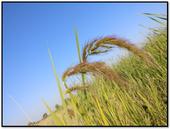- Author: Luca Carmignani
- Editor: Karey Windbiel-Rojas
- Editor: Belinda Messenger-Sikes
- Post: Gale Perez

How can weed control help with wildfire preparedness?
Wildfires are part of California's ecosystems, and they do not have to lead to the destruction of structures and livelihoods. Each of us can contribute to improving wildfire resilience, from individual homeowners and businesses to entire communities. Managing the vegetation and landscape around our homes can play a crucial role in preventing the spread of fires and sources of ignition.
Given the large amount of rain in the winter of 2022-2023, you might have experienced a surge in annual grasses and fast-growing plants that cover most of the ground around your home and community. In my area, I observed invasive species like wild oats and mustard...
- Author: Trina Kleist
- Posted by: Gale Perez

A contraption with a long, low, green metal arm swept noisily along the edge of a row of almond trees in an experimental orchard just west of UC Davis. Little flashes of light sparked between the bottom of the arm and the green weeds below, and puffs of gray smoke wafted up from the stricken pests.
This tractor equipped with an electrical generator may offer one solution for organic farmers looking for new ways to get rid of weeds. Researchers here and at partner universities have embarked on a three-year project to compare how the machine performs compared to herbicides allowed in organic farming, and to hand-weeding, which has become prohibitively costly.
Electrical energy zooms through the plant down into the...
- Posted by: Gale Perez

Managing Weeds in Grasslands and Rangelands (online event)
Tuesday, October 19, 2021
9:00 AM-12:00 PM (Pacific Time)
The latest information on weed control will be presented at the Managing Weeds in Grasslands and Rangelands online event.The lineup of UC Cooperative Extension (UCCE) and UC Davis experts will discuss basic ecology and biology of common weeds in California rangelands, potential benefits of dusting rangelands with compost, grazing for weed control (palatable and nutritious or a nuisance and poisonous), invasive weed control research projects in Northeastern California, weeds in grassland...
- Author: Whitney Brim-DeForest

Watergrass
We are having more and more difficulties controlling watergrass over the past 20 or so years. We know that as of the early 2000s, we had found multiple-herbicide resistant late watergrass (also known as mimic), as well as multiple-herbicide resistant barnyardgrass. For early watergrass, we now have resistant biotypes (to thiobencarb), with none recorded as being multiple-herbicide resistant.
In 2017, two rice fields were identified with an unknown watergrass biotype (or species) that looked very different than the three main known species that infest California rice fields (late watergrass, early watergrass, and barnyardgrass). Both fields had...
- Author: Whitney Brim-DeForest

In 2017, I started getting reports of a watergrass biotype/species (Echinochloa spp.) that was difficult to control using our suite of herbicides registered in rice. At the time, I knew we had multiple herbicide-resistance in late watergrass (Echinochloa phyllopogon), so I initially just thought the resistant biotype was spreading, and had maybe gained resistance to additional herbicide modes of action. However, once I started visiting fields, it quickly became apparent that this was not late watergrass (phenotypically-speaking). It also did not appear to be barnyardgrass (Echinochloa crus-galli), although the Echinochloa species are notoriously difficult to identify, and phenotypically quite variable in...


